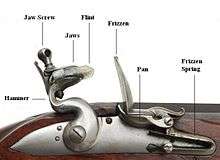Frizzen

The frizzen, historically called the steel,[1] is an "L" shaped piece of steel hinged at the rear used in flintlock firearms. It is positioned over the flash pan so as to enclose a small priming charge of black powder next to the flash hole that is drilled through the barrel into where the main charge is loaded. When the trigger is pulled, the hammer or cock—which includes a shaped piece of flint held into a set of jaws by a scrap of leather or thin piece of lead—snaps forward causing the flint to scrape down the face of the frizzen (historically called the 'battery'), throwing it back to expose the black powder in the pan. The flint scraping the steel causes a shower of sparks to be thrown into the pan, igniting the black powder and sending flames through the touch hole, which in turn ignites the main charge of black powder in the breech of the barrel, shooting the projectile out the barrel.
The development of the frizzen which combines both the "battery" or striking surface and separate pan cover on the less advanced "snaphaunce" lock is often credited to French gun maker Marin le Bourgeoys around 1610. He may have been influenced by the Spanish "miquelet" lock that utilized a similarly shaped frizzen at least two decades earlier.
It is important that the frizzen be case hardened to a high carbon content. Materials such as horn or hooves were wrapped around the frizzen which were then placed into a fire for several hours to increase the carbon content of the steel. It is important to keep the fire below the melting point of the steel. This process hardens the outside while the center stays relatively ductile so as to prevent cracking. With continued use a frizzen will lose its ability to create enough sparks to reliably ignite the powder. As such it needs to be rehardened or replaced.